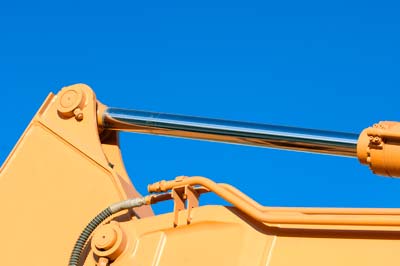The Use of LVDTs to Control Hydraulic Actuators
Written by transtek_admin on 03/29/2023

Hydraulic actuators are used in a wide range of high-force applications including cranes, excavators, feeder/agitator drives, planes, military vehicles and more. In order to facilitate proper performance for many of these uses, it’s critical to constantly measure position and transmit accurate real-time data. LVDTs have proven to be a suitable, durable and relatively cost-effective way to achieve this.
It’s interesting to note that in some cases, measurement by means of a sensor is not necessary. Hydraulics will simply just do their job. In other applications, such as heavy equipment, the operator may glance at the hydraulics, and use this visual feedback to control them accordingly.
LVDT’s: A Must for Hydraulic Automation
Though thanks to the ever-increasing growth of automation, the need for real-time, precise feedback is becoming more common. Traditional hydraulics assemblies are still doing the movement, but LVDTs are often used to indicate position, specifically how far they are extending out or pulling back in, and how fast they are moving. The data is then fed back to automated controls, which will make adjustments as needed based on what it’s been programmed to do. Also, for many applications, automated or not, the hydraulics are completely sealed and out of view, so visual feedback is not an option.
LVDT Use Cases for Hydraulics
Aviation – hydraulics are used on planes to move and actuate landing gear, brakes and flaps. Just imagine, it would be impractical for a pilot to look out to see a flap’s position, this is where LVDTs come in. They can determine position, and communicate it back to the cockpit in real-time. For safety reasons, there’s often redundancy. For instance, the system may be comprised of a transducer, and a backup twin transducer. The transducers may also be configured to feed multiple controllers, depending on how the system was designed.
Plastics Molding – hydraulic control systems on molding machines may be used for actuating core pulls, ejectors, and valve gates. LVDTs can determine key factors such as determining if plastic is being pulled all the way through. Also, is it moving at the required speed? Position data can be used to tell how quickly it’s moving. In certain cases, separate sensors may also be used to measure speed.
Hydraulic Drilling Rigs – here, hydraulic pressure is used to generate the required force. Feedback is critical, especially if horizontal drilling is taking place. It’s important to know exactly how that drill is moving. Variables such as hardness must be understood as well, to make sure drilling is happening at an appropriate rate.
Alternatives to LVDTs
There are alternatives to LVDTs for hydraulics measurement. The most cost-effective approach is to use a resistive type transducer. As a tradeoff to cost savings, these sensors offer the least resolution of the options. On the other hand, magnetostrictive linear position sensors may also be used. While these would be the most expensive option, they are typically more compact than LVDTs, and offer the highest resolution. LVDT’s fall right in the middle on price. They are the largest, but also the most rugged. While magneto-restrictive may be ideal for certain space-limited applications, LVDTs are often selected for hydraulic applications. They are the most durable and reliable, and deliver an excellent performance-to-price ratio.
